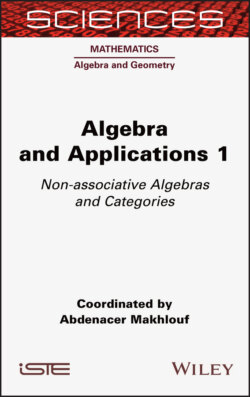Читать книгу Algebra and Applications 1 - Abdenacer Makhlouf - Страница 21
1.7.1. Superalgebras of rank ≥ 3
ОглавлениеIn this section, we consider Jordan bimodules over finite dimensional simple Jordan superalgebras of rank ≥ 3, that is, superalgebras Josp(n, 2m), n + m ≥ 3; Q(n)(+), n ≥ 3; JP(n), n ≥ 3.
In this case, the universal multiplicative enveloping superalgebra U(J) is finite dimensional and semisimple (Martin and Piard 1992). Hence every Jordan bimodule is completely reducible, as in the case of Jordan algebras.
The superalgebras Josp(n, 2m) and JP(n) are of the type
where A is a simple finite dimensional associative superalgebra and ∗ is an involution.
EXAMPLE 1.25.– An arbitrary right module over A is a one-sided module over H(A, ∗).
EXAMPLE 1.26.– The subspace K(A, ∗) = {k ∈ A | k∗ = –k} with the action k ∙ a = ka + ak; k ∈ K(A, ∗), a ∈ H(A, ∗) is a unital H(A, ∗)-bimodule.
THEOREM 1.6 (Martin and Piard (1992)).– An arbitrary irreducible Jordan bimodule over Josp(n, 2m), n + m ≥ 3, or JP(n), n ≥ 3, is a bimodule of examples 1.25 and 1.26 or the regular bimodule.
The superalgebras , Q(n)(+) are of the type A(+), where A is a simple finite dimensional associative superalgebra.
EXAMPLE 1.27.– Every right module over A gives rise to a one-sided Jordan bimodule over A(+).
Suppose now that the superalgebra A is equipped with an involution ∗.
EXAMPLE 1.28.– The subspaces H(A, ∗) and K(A, ∗) become Jordan A(+)- bimodules with the actions:
1 1) h ○ a = ha + a∗h;
2 2) h ○ a = ha∗ + ah;
3 3) k ○ a = ka + a∗k;
4 4) k ○ a = ka∗ + ak;
where h ∈ H(A, ∗), k ∈ K(A, ∗), a ∈ A.
The associative superalgebras Mm+n(F), where both m, n are odd, and Q(n), are not equipped with an involution, but they are equipped with a pseudoinvolution.
DEFINITION 1.20.– A graded linear map ∗ : A → A is called a pseudoinvolution if (ab)∗ = (–1)|a|∙|b|b∗a∗, (a∗)∗ = (–1)|a| a for arbitrary elements .
EXAMPLE 1.29.– The mapping is a pseudoinvolution on Q(n).
EXAMPLE 1.30.– The mapping is a pseudoinvolution on Mm+n(F).
Replacing the involution ∗ in example 1.28 with the pseudoinvolutions of examples 1.29 and 1.30, we get unital Jordan bimodules over Mm+n(F), where m, n are odd, and over Q(n)(+).
THEOREM 1.7 (see Martin and Piard (1992), Martínez et al. (2010)).– An arbitrary irreducible Jordan bimodule over , m + n ≥ 3 or Q(n)(+), n ≥ 3, is one of examples 1.27 and 1.28 with an involution or a pseudoinvolution, or a regular bimodule.
The exceptional Jordan superalgebra K10 has rank 3. Jordan bimodules over K10 have been classified by Shtern (1987).
THEOREM 1.8 (Shtern (1987)).– All Jordan bimodules over K10 are completely reducible. The only irreducible Jordan bimodules over K10 are the regular bimodule and its opposite.
